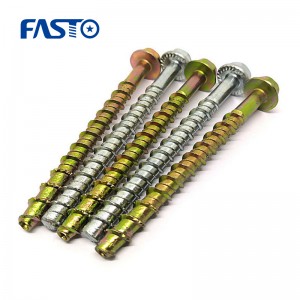Concrete screws are versatilefastenersdesigned specifically for securing objects to concrete, brick, or masonry surfaces. Whether you’re a professional contractor or a DIY enthusiast, understanding the uses, types, and installation process ofconcrete screwscan significantly simplify your construction or renovation projects. In this article, we will delve into the world of concrete screws and provide you with valuable insights.
1.Applications of Concrete Screws:
1) Securing wall frames and partitions :Concrete screws are ideal for fastening wall fixtures like shelves, cabinets, and TV mounts to concrete or masonry walls. They provide a sturdy hold and eliminate the need for complicated anchoring systems.
2) Installing electrical boxes and conduits:Concrete screws are essential for safely mounting electrical boxes and conduits to concrete walls, ensuring secure installation.
3) Fence and gate installation :When installing fences or gates on concrete surfaces, concrete screws offer a reliable solution for securely fastening posts to the ground without the need for additional support.
4) Outdoor furniture assembly :Concrete screws are also useful for assembling outdoor furniture, such as benches, tables, or pergolas, helping to create durable and long-lasting structures.
2.Types of Concrete Screws:
1) Tapcon screws :Tapcon screws are one of the most commonly used types of concretescrews. They feature a high-quality blue-colored, corrosion-resistant coating for enhanced durability. Tapcon screws are available in various lengths and diameters, compatible with a wide range of applications.
2)Sleeve anchors:Sleeve anchors consist of an expanding sleeve, a threaded stud, and a nut. They provide excellent holding power and are suitable for heavy-duty applications that require significant load resistance.
3) Hammer drive anchors :Hammer drive anchors are designed for fast and secure installation. They have a metal body with expandable ribs that provide proper grip and stability. Hammer drive anchors are popular for attaching materials to concrete, brick, and block surfaces.
3.Installation Process:
1) Preparing the surface Ensure that the surface is clean and free from dust, debris, or loose particles. Use a wire brush or vacuum cleaner to remove any contaminants.
2) Selecting the proper screw and drill bit Choose the appropriate concrete screw and drill bit size based on the thickness of the material and the desired load capacity. Consult the manufacturer’s guidelines for the recommended specifications.
3)Drillingpilot holes Using the drill bit, carefully drill pilot holes into the concrete, ensuring they are deep enough to accommodate the screw length.
4) Inserting and fastening the screw With the pilot holes prepared, insert the concrete screw into the hole and rotate it clockwise using a screwdriver or power drill until it is securely fastened. Avoid overtightening to prevent material damage.
Our Website:/
If you need any help about products,pleasecontact us.
Post time: Sep-06-2023


